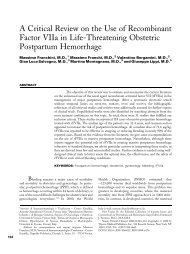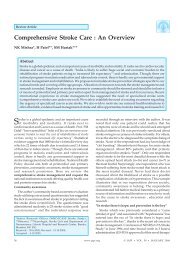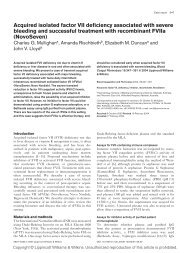Pathophysiology and management of dengue hemorrhagic fever
Pathophysiology and management of dengue hemorrhagic fever
Pathophysiology and management of dengue hemorrhagic fever
Create successful ePaper yourself
Turn your PDF publications into a flip-book with our unique Google optimized e-Paper software.
CHUANSUMRIT & TANGNARARATCHAKIT | MANAGEMENT OF DENGUE HEMORRHAGIC FEVER 9<br />
Grade I,II (DHF)<br />
Poor appetite, N/V<br />
5% D/NSS 5 ml/kg/hour for 1–2 hours 7 mL/kg/hour for 1–2 hours<br />
Improved<br />
Not improved<br />
Hct<br />
Hct<br />
Stable VS<br />
PR , PP<br />
Adequate urine<br />
output (≥ 2ml/kg/4 hours)<br />
Urine < 0.5 ml/kg/hour<br />
5% D/NSS<br />
3 mL/kg/hour for 6–18 hours<br />
Gradually decrease IV fluid<br />
to maintenance or less for<br />
24–48 hours if Hct, VS stable,<br />
adequate urine output<br />
VS, Hct, urine output<br />
5% D/NSS<br />
Figure 2. Algorithm for treating patients with <strong>dengue</strong> <strong>hemorrhagic</strong> <strong>fever</strong> during the toxic stage. Adapted from Ramathibodi<br />
Clinical Practice Guideline. 54,55 —— improved; ------, not improved; colloid, includes Dextran 40, Haemaccel®, 5% albumin<br />
or fresh frozen plasma; DHF, <strong>dengue</strong> <strong>hemorrhagic</strong> <strong>fever</strong>; DSS, <strong>dengue</strong> shock syndrome; VS, vital signs; BS, blood sugar;<br />
N/V, nausea <strong>and</strong> vomiting; LFT, liver function test; Cr, creatinine; BUN, blood urea nitrogen; PR, pulse rate; PRBC, packed<br />
red blood cells; CVP, central venous pressure; PP, pulse pressure; IV, intravenous; Hct, hematocrit.<br />
effective response (66.7%) than the delayed initiation<br />
(29.8 hours) in the mainly grade IV DHF (33.3%). Moreover,<br />
patients previously administered ibupr<strong>of</strong>en or the<br />
volume exp<strong>and</strong>ers dextran 40 <strong>and</strong> Haemaccel tended to<br />
Grade III (DSS)<br />
5% D/NSS 10 ml/kg/hour for 1–2 hours<br />
5–10 ml/kg/hour for 1–2 hours<br />
5% D/NSS<br />
7 ml/kg/hour for 1–2 hours<br />
Toxic stage<br />
Not improved within 1/2 hours<br />
Unstable VS,<br />
No urine output<br />
© 2006 The Authors<br />
Journal Compilation © 2006 LMS Group • Transfusion Alternatives in Transfusion Medicine 8 (Suppl. 1), 3–11<br />
Hct<br />
Colloid 10 ml/kg/hours<br />
for 1–2 hours<br />
Grade IV (DSS)<br />
Check BS, electrolytes, Ca, LFT, BUN, Cr<br />
coagulogram, crossmatch for blood components<br />
NSS 10 mL/kg in 10–15 minutes<br />
Assess<br />
NSS 10 mL/kg in 10–15 minutes<br />
Hct<br />
PRBC 10 ml/kg drip in 1 hours<br />
Improved Not improved Monitoring in ICU<br />
have a less effective response (28.6%) than patients<br />
without associated medications (75.0%). The case–<br />
fatality rate was 20% (3/15). No clinical evidence <strong>of</strong><br />
thromboembolic complication was observed.





